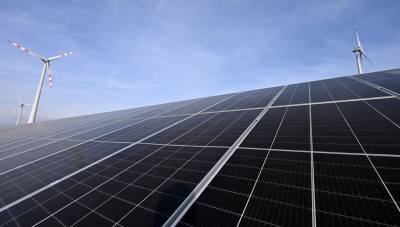Electricity production currently almost exclusively renewable


The skies over Austria are bright blue these days, which is why photovoltaics are booming. Solar energy currently accounts for the largest share of Austrian electricity generation during the day, according to data from the Austrian Power Grid (APG). This is followed by hydropower, which has been suffering from low water levels since the beginning of the year. Wind power ranks third, where the lull associated with the heat across Europe is causing lower capacity utilization.
According to APG data, photovoltaic power generation was around 4,500 megawatts (MW) at midday on Wednesday, run-of-river hydropower generated approximately 1,900 MW, and wind power around 500 MW. Fossil fuels currently play a minor role in Germany during the day; gas-fired power plants fed in approximately 25 MW at midday.
Thermal power plants lack cooling water
Heat is relevant, for example, for thermal power plants, whose production depends on the availability of cooling water from rivers. If water is lacking or cannot be used due to nature conservation regulations, electricity production must be throttled. This already applies to some nuclear power plants in France and Switzerland, but other thermal power plants, such as gas-fired power plants, also operate this way. Thermal power plants "live off the temperature difference," said E-Control economist Johannes Mayer in an interview with APA.
However, high achievable wholesale prices led to gas-fired power plants in Germany, which can be ramped up quickly, coming online overnight from Tuesday to Wednesday. "The power plants are also running for foreign customers," Mayer said.
Heat wave slows down wind power
The so-called heat wave plays an important role in this. High temperatures typically don't produce strong winds. This is currently the case in Austria, but the lack of wind and the resulting lack of wind power in Germany is having a major impact on the European electricity market, according to Mayer.
In Austria, hydropower has traditionally played a major role in electricity generation. It continues to make a significant contribution, but water levels in Austria's rivers have been below average since the beginning of the year. Hydropower generation at the nationwide electricity company Verbund in 2025 is currently at 76 percent of the long-term average. This is "within the long-term fluctuation range, but is one of the driest (half-)years in 100 years," the company said in response to an APA inquiry. The Austrian Energy Association also sees regionally varying low water levels, but overall, no problems with electricity generation.
Global warming brings shifts in hydropower
Generally, a seasonal shift can be observed in hydropower, Mayer said. In the past, snowmelt provided water in the rivers from spring and into summer, but now hydropower production is increasingly shifting to winter and spring. Verbund reports similar results: "In the past, snowmelt ensured continuous hydropower generation in the summer. Human-induced global warming is causing more frequent extreme events such as droughts and heavy rainfall. This is shifting generation in the major river systems."
Hydropower is currently also benefiting from melting glaciers, a spokesperson for the association told APA. Glacier areas in Austria have shrunk rapidly in recent years. If global warming is not limited to 1.5 degrees Celsius, researchers expect the country's glaciers to disappear by the end of the century.
APA
energynewsmagazine


